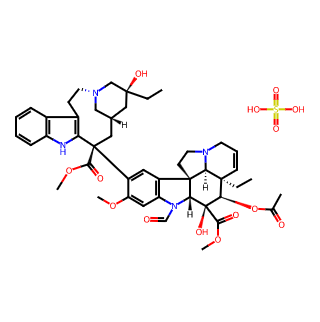- Synthetic anti-infective drugs
- Medications for the digestive system
- Antipyretic and analgesic drugs
- Medications for the blood system
- Medications for the respiratory system
- Anti-allergic drugs
- Medications for the urinary system
- Diagnostic medications
- Immunosuppressive and immunomodulatory drugs
- Vitamins and mineral supplements
- Antioxidants and medications for osteoporosis
- Antiparasitic drugs
- Ophthalmic medications
- Amino acids and their derivatives
- Dermatological medications
- Medications for the circulatory system
- Antitumor drugs
- Medications for the nervous system
- Hormonal and endocrine function-regulating drugs
- Antibiotics
- Others
CAS Number: 2068-78-2




I. Basic Information
Product Name: Vincristine Sulfate
CAS Number: 2068-78-2
Molecular Formula: C46H58N4O14S (note: there may be slight variations in the molecular formula reported in different literature, such as C46H56N4O10·H2SO4, but the core structure remains the same)
Molecular Weight: 923.04
II. Physical Properties
Appearance: Typically a white to off-white solid powder
Melting Point: Approximately 300°C (specific melting points may vary depending on preparation methods and purity)
Boiling Point: 273~281°C (this range may change depending on experimental conditions)
Solubility: Soluble in DMSO (dimethyl sulfoxide) with high solubility, also soluble in other organic solvents such as DMF (N,N-dimethylformamide), but relatively insoluble in water. Specific solubility may vary depending on product purity and solvent type.
Storage Conditions: It is recommended to store under argon gas, sealed, at 4°C in a dry, dark place, or directly at -20°C with a shelf life of up to 3 years. Avoid repeated freeze-thaw cycles to ensure product stability.
III. Chemical Properties and Biological Activity
Chemical Structure: Vincristine sulfate belongs to the vinca alkaloid class of compounds with a specific chemical structure including a tetracyclic skeleton and multiple functional groups.
Mechanism of Action: By binding to tubulin and inhibiting microtubule formation, it irreversibly blocks the mitotic division of tumor cells. This mechanism makes vincristine sulfate an effective antitumor drug.
Biological Activity: It has broad antitumor activity with inhibitory effects on various tumor cells. In cellular experiments, at low concentrations, it inhibits spindle formation leading to chromosome separation failure and metaphase arrest; at high concentrations, it may interfere with and induce complete microtubule depolymerization.
IV. Uses and Benefits
Primary Uses: For the treatment of hematological tumors such as acute leukemia and malignant lymphoma, as well as related diseases such as pediatric sarcomas.
Clinical Applications: As one of the chemotherapy drugs, vincristine sulfate is often used in combination with other drugs to enhance treatment efficacy and reduce side effects.
Research Applications: It is also widely used in cancer research as a tool drug in fields such as multidrug inhibition and monoamine oxidase inhibition.

Tai Yau Street, San Po Kong, Kowloon, Hong Kong, China.



